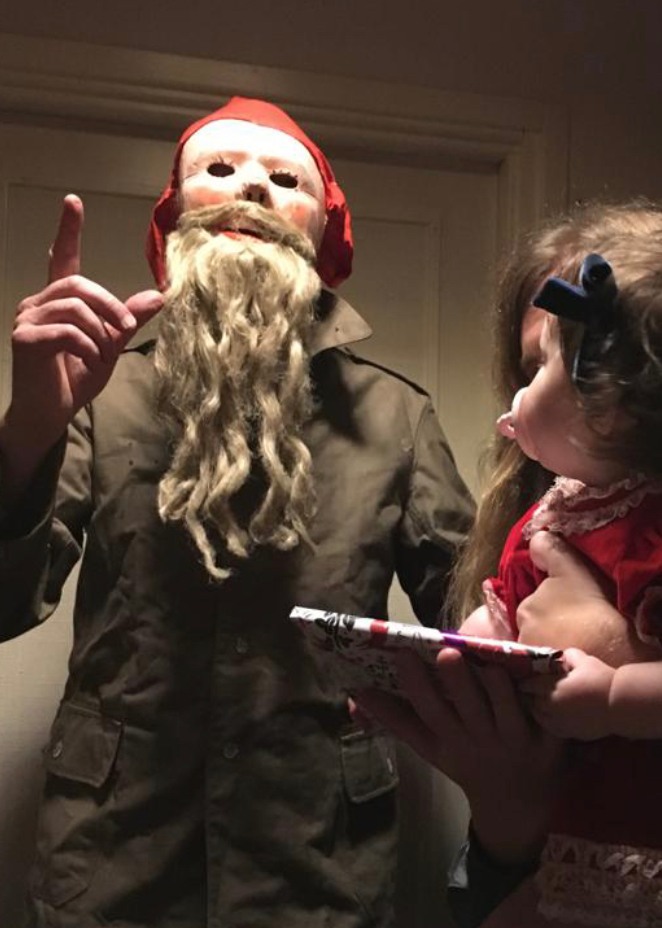How Santa Claus Is Coming To Town

The middle of winter has, for millennia, been a time of celebration. Filled with colors, good cheer, spirits, and gifts, the underlying notion of a winter holiday draws from the realities of humanity’s more difficult times: scarcity in a cold and darker season. In the Northern Hemisphere, humans have coincidentally aligned around late December (in the Southern Hemisphere, similar ancient celebrations found their home in June) and from Ancient Romans’ Saturnalia, to Indigenous Americans’ Shalako, to the Persian Shab-e Yalda, cultures have long held feasts and celebrated holidays around the winter solstice.
In time, popularized through media, adopted in religion, and commercialized by trees with gifts, Christmas has emerged as one of the world’s most celebrated holidays; a cultural and commercial event practiced in countless ways. People of varied cultures have been celebrating it similarly for two millennia, thanks to the impact of Christianity and the coinciding date chosen to celebrate the birth of Jesus of Nazareth, the spiritual leader whose teachings form the foundation of the Christian faith. Gift-giving, Christmas tree decorating, going to church, and gathering with loved ones to eat and drink are just a few of the many traditions that people engage in throughout the holiday season.
Most of us are aware of its popular roots in culture – underpinnings in Christianity, visions of sugarplums thanks to Clement Clarke Moore‘s visit from St. Nicholas, Montgomery Ward’s reindeer with a red nose, and A Christmas Carol in a book – but it’s a deeper dive into the history of Kris Kringle that reveals how Santa might be the greatest startup story of all time.
The Night Before Santa Claus
It is known that “Christmas” (established as such) was first and foremost a Christian celebration; before that establishment by Christianity, it was a winter solstice event celebrated in its various forms with all the trimmings and traditions of that distinct culture. The establishment of Christmas united various cultures through shared religion and with that, came traditions from throughout the world, united into one holiday marked by attendance at church and sacred melodies. Candles warmed the dark and, being associated with the most notable of respective events, gilded altarpieces were brought forth while clergy donned their best. As the church (churches all) played a part in so much of early education, caring for orphans, and of course spreading their gospel, in time, parishioners and actors joined and perform scenes from the story of the Nativity; a work of theater, with costumes and even live animals, and in reference to the gifts of gold frankincense, and myrrh given to baby Jesus, gift giving to friends and family grew from a simple solstice sign of caring to a commercialized expectation.
Today, far fewer partake the religious aspects. Retailers ride on the Christmas spirit with special deals to boost their sales while our entertainment industry cranks out Christmas films, music, and decorations as early as October.
All thanks, to the birth of a saint, in 280 A.D.
Wait, what? I thought this was about Jesus 2,000 years ago.
Nope, we’re here to talk about a monk named St. Nicholas, born around 280 in Patara, near Myra in modern-day Turkey.
A Startup Carol
In much of our work with startups and entrepreneurs, in our new market entry programs for companies seeking to grow into other countries such as the U.S., our media oriented experiences and values reiterate what the world-over knows about what a successful company makes: it starts with why and grows with the stories that appeal to the market.
Having covered a bit of the why in the story of Santa Claus, let’s look further into the stories that gave rise to the greatest startup ever told.
Nicholas’ popularity spread and he became known as the protector of children and sailors. His feast day is celebrated on the anniversary of his death, December 6, which traditionally become considered a lucky day to make large purchases or to get married. By the Renaissance, 14th to 17th century, St. Nicholas was the most popular saint in Europe.
It was the role of the Newspaper industry that first pivoted our Christmas startup.
In December 1773, a New York newspaper reported that groups of Dutch families had gathered to honor the anniversary of his death. The name Santa Claus evolved from nickname used by those Dutch families, Sinter Klaas, a shortened form of Sint Nikolaas. This sparked the interest of popular culture and in 1804, John Pintard, of the New York Historical Society, distributed woodcuts of St. Nicholas at the society’s annual meeting. The background of the engraving contained now-familiar imagery such as stockings filled with toys and fruit hung over a fireplace.
In 1809, stories of Sinter Klaas were popularized this time by a book, when Washington Irving referred in his book, The History of New York, to St. Nicholas as the patron saint of New York. With time, popularity, and other cultural influences, Sinter Klaas was described as everything from a “rascal” with a blue three-cornered hat, red waistcoat, and yellow stockings to a man wearing a broad-brimmed hat and a “huge pair of Flemish trunk hose.”
In 1822, Clement Clarke Moore penned a poem for Christmas, for his three daughters, entitled “An Account of a Visit from St. Nicholas,” more popularly known as “‘Twas The Night Before Christmas.”
Moore felt his poem was too frivolous and hesitated to allow broader publication; it is all but responsible for our shifting our thinking of St. Nicholas from a colorful and kind person of old to our modern “right jolly old elf.” With a portly figure and the Marvel-like super power to teleport through a chimney, Moore’s poem helped popularize our image of a Santa Claus who flew from house to house with eight flying reindeer in “a miniature sleigh.”
It was a newspaper, a poem, and book, that turned ideas into one of the most well known brands in the world.

On December 19, 1843, “The man who invented Christmas,” Charles Dickens‘ published “A Christmas Carol,” calling to mind those most ancient of causes for the holiday, colors, good cheer, spirits, and gifts, during a most troubling set of circumstances. Notably, not a story of our now familiar Christmas, Moore’s image, nor Christian’s saints, but the spirit of it (and a Ghost of Christmas Present who hopefully looks a little familiar).
“Santa Claus” was really, ultimately, born of commerce.
The Greatest Startup Ever Told
The Christmas shopping season is the most effective marketing campaign of all time. Should you only be familiar with the commercial notions of Black Friday, and its eCommerce based twin Cyber-Monday, know that Black Friday refers to the time of the year when retailers traditionally found themselves “in the black” (with net positive revenue and profits) after nearly 11 months into the year. When families gathered for Thanksgiving in the United States, took advantage of the brief vacation from work, they took to the stores to shop for Christmas gifts.
Long before Amazon, Toys R Us, even the Sears Catalog that many of fondly recall pouring over to craft our wish lists, a friendly competition between Montgomery Ward and Macy’s turned to the media to drive shoppers and families to see Santa Claus.
The Store Santa was already a popular draw, in the 1920s, The Coca-Cola Company began Christmas advertising through shopping-related ads in magazines like The Saturday Evening Post. Their earliest ads defined the look of Santa, drawn from earlier works of Thomas Nast.
In 1930, artist Fred Mizen famously painted a department-store Santa in a crowd drinking a bottle of Coke.
Rudolph the Red-Nosed Reindeer first appeared in a marketing campaign for retailer Montgomery Ward for which the company gave away coloring books each Christmas to bring children and their parents into their store. Describing the campaign as ‘the perfect Christmas crowd-bringer,’ the company gave away more than 2 million copies of the book in their first year, rising to 6 million copies by 1946.
Macy’s responded in kind, in film. A young Natalie Wood starred as a creative and curious little girl whose well-meaning mother raised her not to believe in Santa. Their lives meet with an elderly man, by the name of Kris Kringle, who, has been hired by Macy’s department store play Santa Kringle is placed in a mental hospital, so of course, not only isn’t actually Santa but obviously can’t be no matter how much he might believe he is. At the sanity hearing, Kringle and his attorney attempt to prove that he is indeed Santa Claus.
Though released in the summer, Miracle on 34th Street became a box-office hit and ran in theatres through the holiday season culminating in a certain someone appearing at the end of Macy’s annual Thanksgiving Day Parade, a reminder that he’s on his way to the store.
Prior to 1931, Santa was everything from a tall gaunt man to a spooky-looking elf as, while Moore’s image sparked an idea of the character, he was still derived from a Saintly monk with northern European huntsman characteristics.
Civil War cartoonist Thomas Nast drew Claus for Harper’s Weekly in 1862 as a small elflike figure who supported the Union. Nast continued to draw Santa for 30 years, changing the color of his coat from tan to the red he’s known for today.

How Music, Television, and Film Changed the Way We Celebrate Christmas
Carols like “What Child Is This?” and “O Come, O Come Emmanuel” are some of the first Christmas songs written; from unknown authors in the Middle Ages, we hark the herald angels sing because of the roots of Christmas well before the season we’ve come to know thanks to the 1800s. In the 1700s, composer George Frideric Handel released a collection of Christmas tunes, driving popularity for the Christian Christmas even more as “Joy to the World,” “Angels We Have Heard on High,” and “O Come All Ye Faithful” are three of the most popular songs during this time.
When 1800s came, some churches started playing “Silent Night” and “O Holy Night”. These are two of the most popular Christmas hymns of all time (1855).
The first secular song to gain popularity was “Jingle Bells,” created for Thanksgiving in 1857.
Then, in the 1930s, J. Fred Coots and Haven Gillespie wrote that Santa Claus is coming to town, first known to be recorded by Harry Reser with his banjo and band in 1934, popularized by Eddie Cantor‘s radio show in November. An instant hit, 500,000 copies of sheet music and more than 30,000 records sold within 24 hours.
Robert May’s Rudolph the Red-Nosed Reindeer Montgomery Ward children’s book, became a seasonal song in 1949 and that same year, “Baby It’s Cold Outside” became a popular romantic Christmas song.
At the dawn of the 1990s, music quickly moved from carols and rare tune, to being a mainstay of the music industry, Mariah Carey’s Merry Christmas album (1994), Britney Spears’ “My Only Wish”(2000), and N*Sync’s “Merry Christmas, Happy Holidays” (1998) are just a few examples of pop superstars that have made lasting unique holiday tunes. Michael Bublé’s “I’ll Be Home For Christmas,” reigns supreme as a personal favorite while the infectious voices of Pentatonix inspires everyone to sing along.
Accompanied throughout the years by television and film, far more than Miracle on 34th Street, holiday films started to boom as an escape from the real world and a of what might be like if we all, always, held that Christmas spirit. 1946 also saw James Stewart bring George Bailey to life in “It’s a Wonderful Life,” about a community where every single person plays a significant role in the life of a man who feels stuck in his childhood town, disappointed by desires to travel.

On film, a British holiday film took the hearts of the people by showing the lives of eight couples, their trials, and realizations to become a go-to Christmas movie about “Love Actually,” Walter “Jack” Rollins and Steve Nelson wrote, and recorded with Gene Autry and the Cass County Boys and in time with Jimmy Durante, what we know of Frosty the Snowman, Kermit and Gonzo came face to face with Ebenezer Scrooge, John McClane threw Hans Gruber from Nakatomi Plaza because, “’twas the night before christmas, and all through the house, not a creature was stirring, except… the four a******* coming in the rear in standard two-by-two cover formation,” and it just wouldn’t be Christmas without Bing Crosby having a white one.
People may work through their own anxieties and wishes about relationships and self-worth by immersing themselves in a fictitious world through Christmas movies. Film, music, and books, have not just created Santa Claus and popularized the spirit and good cheer, the storytelling of this commercialized world reminds us of optimism in the face of adversity.








I think there is one even better marketing stunt, and that one is:
„Breakfast is the most important meal of the day“
Yes, Santa really went viral around the globe, but his impact is a) limited to maybe 6 weeks per year and b) totally diluted. The connection to Coke has been lost, decades ago.
The breakfast myth, on the other hand, is believed worldwide as well – but every single day. And it‘s still pretty close to the originating company.
Which was…
Kellogg’s
Coincidence? Kellogg’s and that push to normalize corn was a part of a conversation I was having just last week.
Not dissimilar from the DeBeers work with diamonds.
In my caribbean homeland of Trinidad and Tobago, we have added so many traditions by blending Indian, Spanish & Creole traditions.
We even have our own genre of music called parang, then there’s the soca parang and then the Indo-Trinidadian spin, chutney soca parang.
The “Startup” has evolved and adapted to its many Customer segments. However, the “Startups WHY” has endured. Love, peace and joyous wishes to you and everyone.
Beautiful addition Neil. Merry Christmas
Paul O’Brien It’s also the perfect synchronised annual distraction!
Perfect time for shooting fish in barrels.
Santa Clause is a 1994 movie starring Tim Allen. Santa Claus is the man who delivers presents on Christmas day.
That’s so interesting. It’s definitely branding and marketing genius at play.
Built on a story. Neat to think about it this way. Hadn’t thought of it like this before. Thanks!
This is a picture of my dad wearing a Santa’s mask from Sweden from 1915. I feel like the red Santa must have been picked up from somewhere rather than invented by Coca Cola. Just as a reference.

Jonas Wikstrand yeah yeah, read the article
It wasn’t invented by Coca-cola. Monk from Turkey, embraced by Europe and ultimately more associated (stylized) through the Norwegian countries; hence the colors, coat for warmth, and often hoods or other outdoor gear, given the centuries old depictions.
The look we know is a combination of *that* (cool mask to have by the way) plus Clement Clarke Moore’s poem, plus Thomas Nast’s depictions during the civil war … (this is about when your mask came into existence)… those resulting in what was usually found in Department Stores, until Fred Mizen with Coca-Cola rather standardized the look.
I did read it! Missed the piece about Thomas Nast which was the missing link I was fishing for.
1950s Santa Claus definitely has more rum than coke in that glass lol
Might be because of the fly agaric mushroom. Red and white, round, looks familiar? Reindeer love them, that’s why they can fly high
Thanks for that awesome read! Definitely hard-pressed to think of a greater brand. It’s truly interesting how each individual involve, whether by design or chance, built their own brands by associating with this one – and making it even bigger. Merry Christmas and/or Happy Holidays to everyone!
Very interesting. Great work as always!